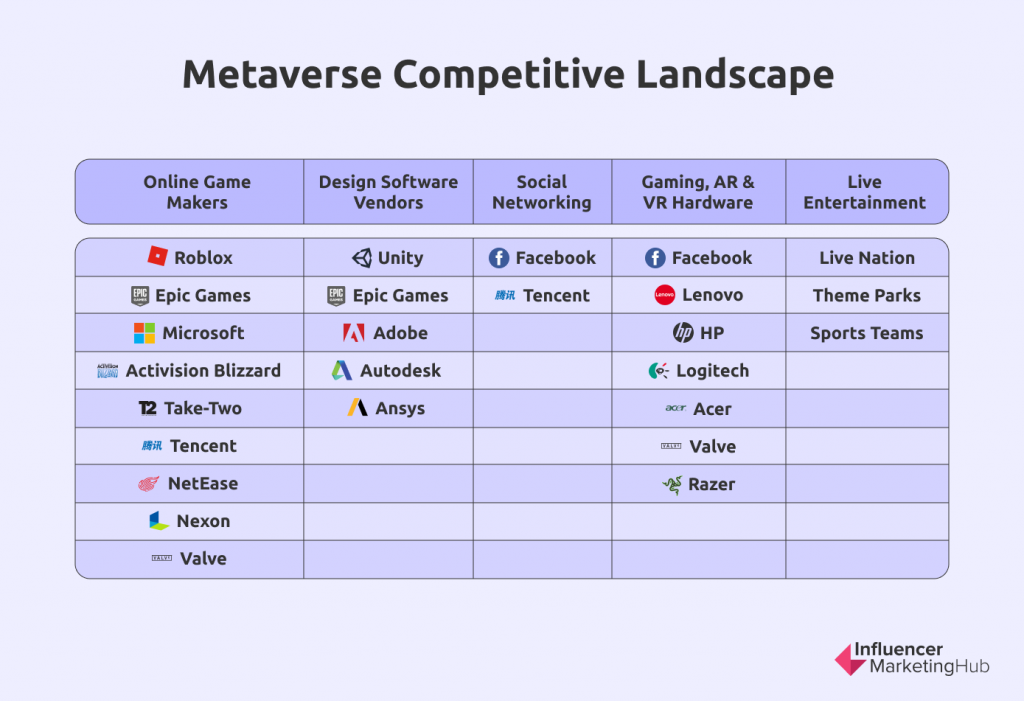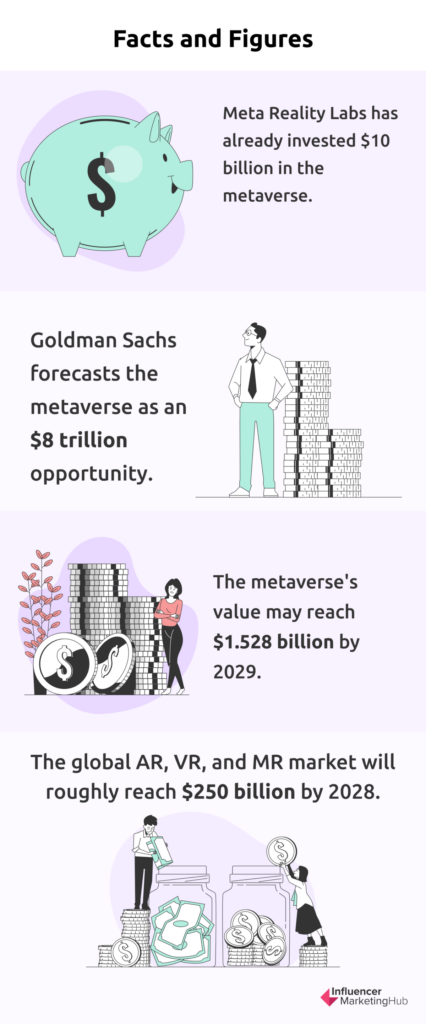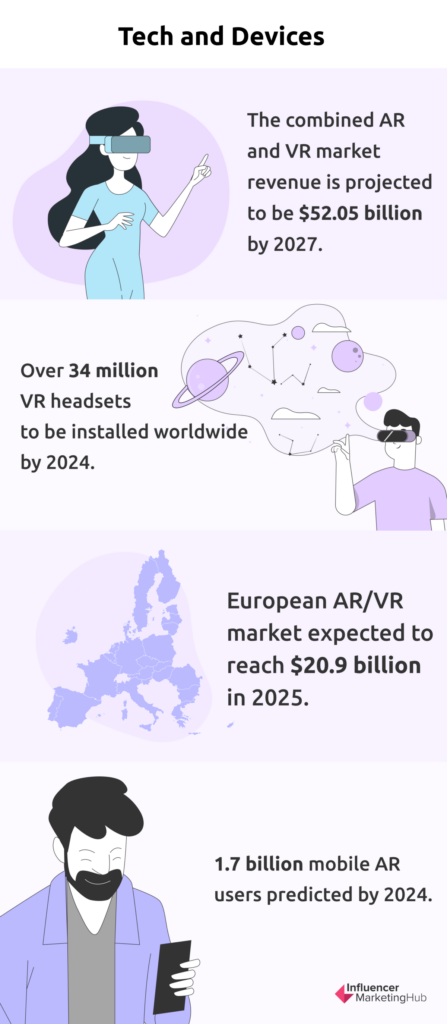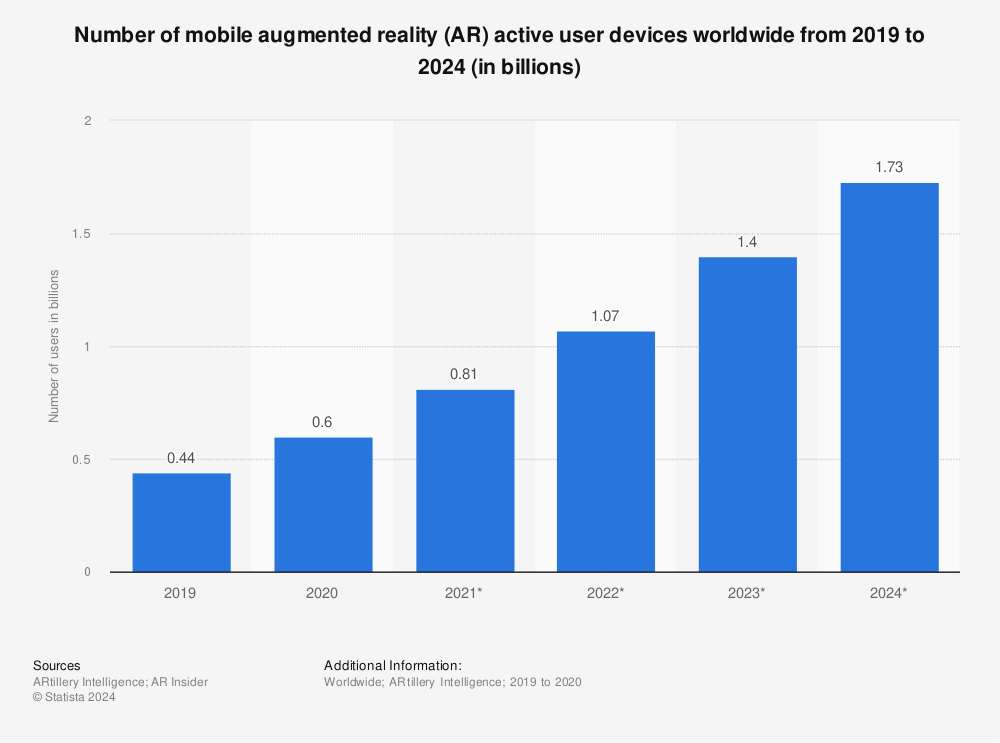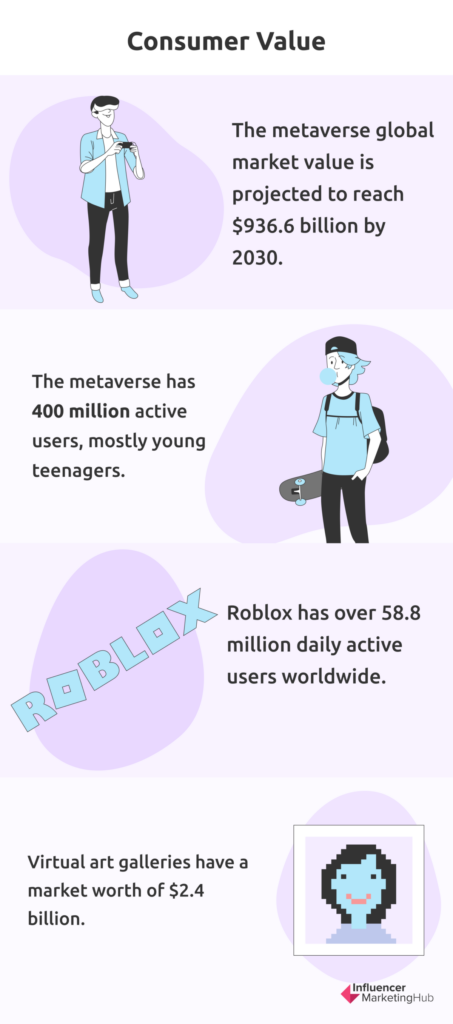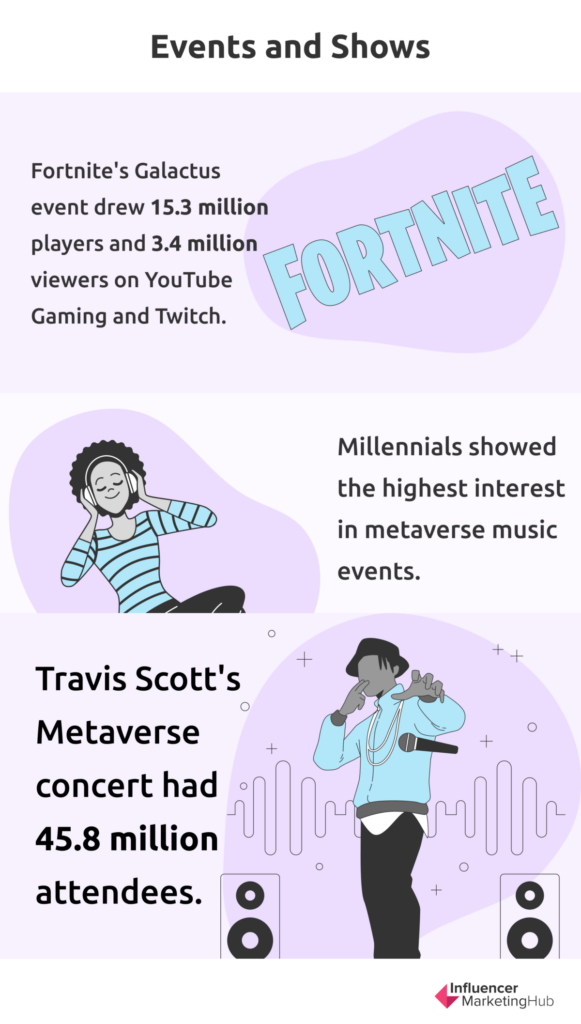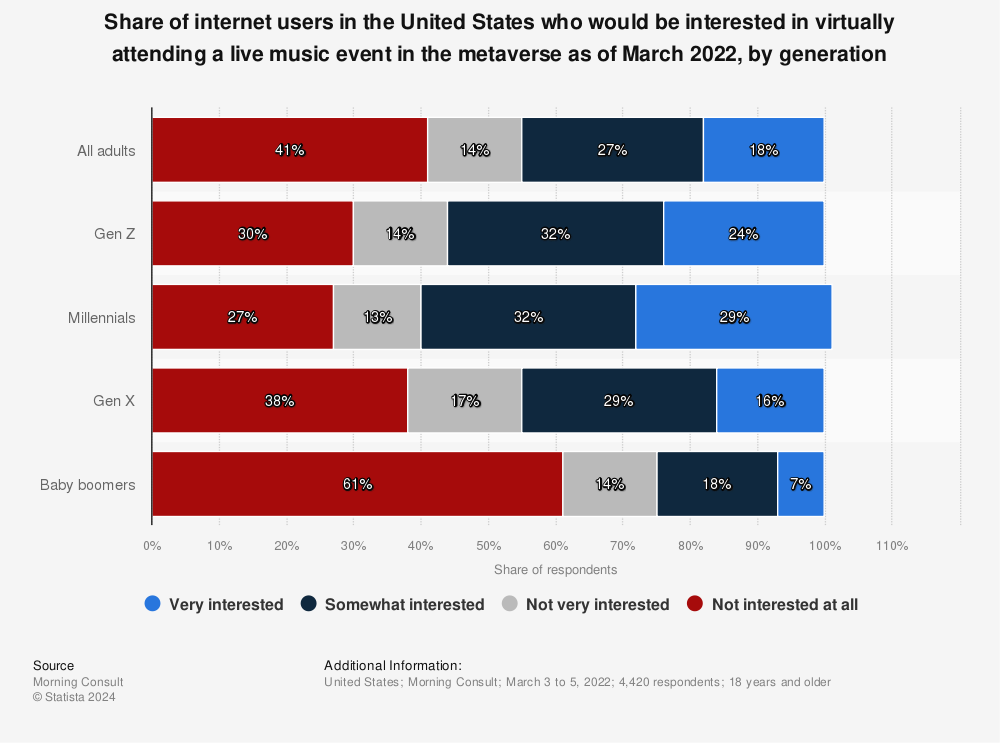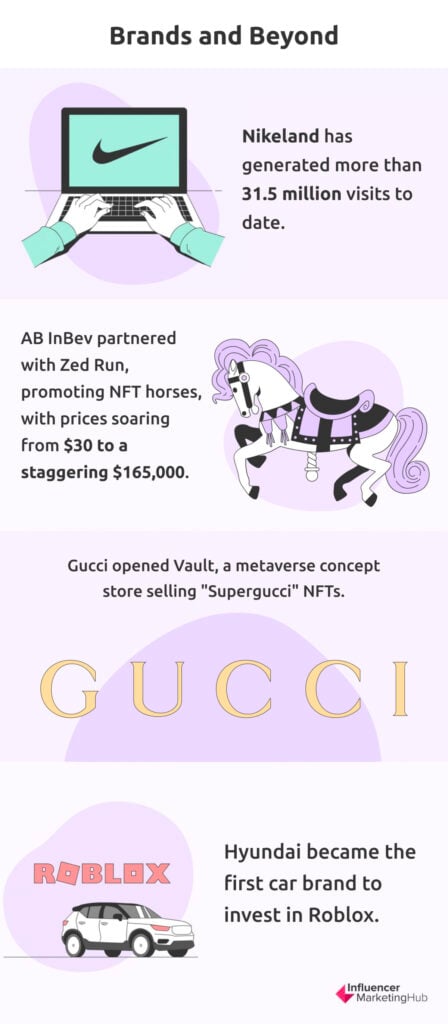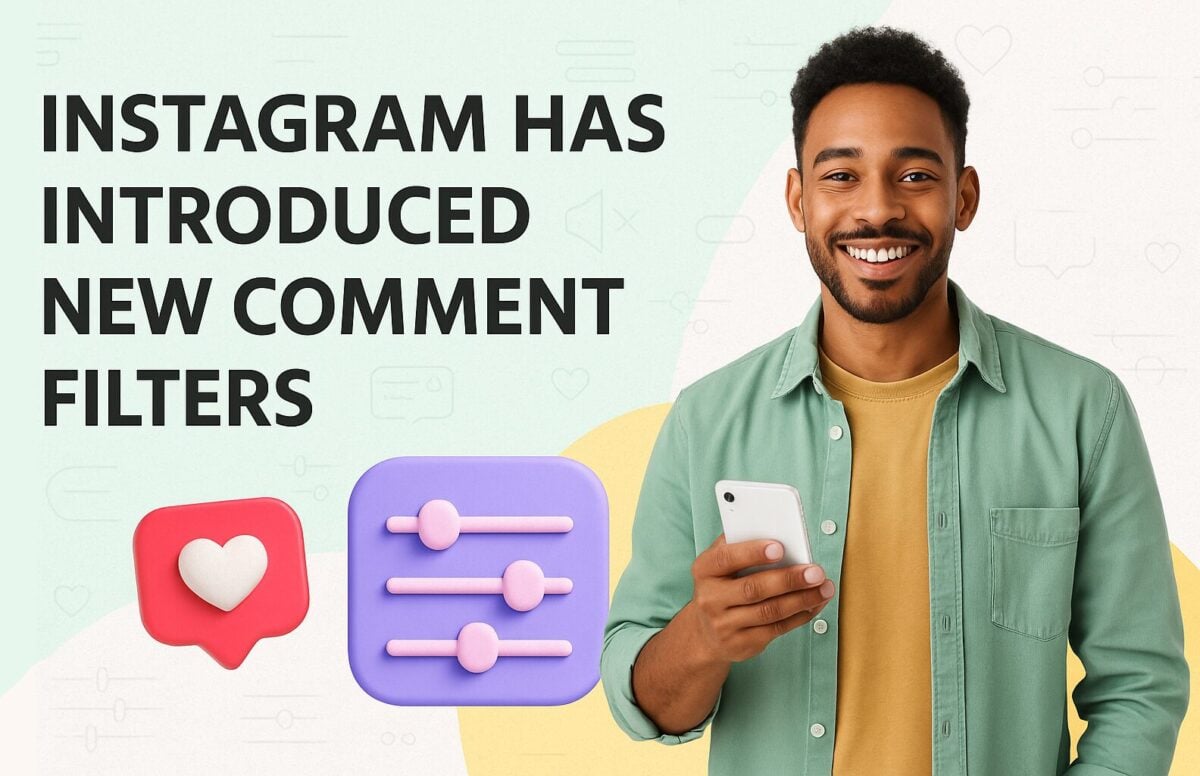A 3D internet is coming with the metaverse, which combines our physical reality with augmented and virtual reality (AR and VR). At least that’s what tech titans and engineers are attempting to create. Because of companies like Microsoft, Meta (formerly Facebook), Epic Games, and Nvidia’s keen interest in the metaverse, we can expect it to grow more popular in 2023.
Metaverse Stats in 2023:
Metaverse 101
The metaverse will have social and economic systems in place, where user avatars can enjoy a wide range of immersed content. Unlike a video game, the overall experience doesn’t pause or end. One of the most notable aspects of this new virtual world is its unprecedented interoperability. Imagine purchasing a Roblox skin and then using it in Fortnite or other online games effortlessly.
As Mark Zuckerberg said, “Metaverse isn't a thing a company builds. It's the next chapter of the internet overall.”
Forbes named the metaverse one of the top ten trends everybody must be ready for in 2023. Global spending on VR/AR, the metaverse's foundation technologies, is expected to rise from $12 billion in 2020 to $72.8 billion in 2024. Because of this, leaders in industries like gaming, retail, arts, healthcare, and blockchain are determining how to position themselves as critical players in this emerging ecosystem.
The metaverse concept is enormous. Initially, there will be a variety of metaverses, and some will focus on specific interests like gaming or sports. Meta's vision is a 3D social media channel with AI-driven messaging tailored to each user. Additionally, metaverse can also be a hub for information, entertainment, and work. It will likely evolve into the next version of the internet.
The metaverse's immersive capabilities set it apart from today's tech. Imagine virtually witnessing a historical event instead of reading about it, or watching a basketball game in 360-degree surround sound rather on a TV set. Attending a conference virtually and interacting with others as if they were with you will be possible, because your metaverse presence will augment your physical one.
Metaverse Buzzwords
Because the metaverse is still evolving, many people struggle to comprehend its operation. Its arrival, however, promises to facilitate new forms of human connections, work, leisure, and even travel.
Mirror-world
The metaverse offers 3D environments via headsets, glasses, and connected watches. As a result, the metaverse is both a mirror of reality and a new universe, allowing the creation of an advanced reality with innovative scenarios. Experts call this digital copy of reality the "mirror-world."
Digital twin
Digital twin refers to a virtual representation of an object or aspect of real life. In this sense, the metaverse is fascinating because you can be whoever you want. An avatar will represent you, and this online character can either mimic your physical characteristics or take on a completely different form.
Mixed realities
Mixed reality (MR) technology, which combines VR and AR, allows total immersion in the metaverse. Users can interact with virtual and physical objects, and digital items can communicate with both.
In VR, complete engagement in the digital world is possible with the use of a special pair of glasses or a helmet. A roller coaster simulation provides a similar sensation. In AR, a digital overlay projects images and graphics onto the real world. Pokémon Go is an excellent example of AR where the characters are captured in real-world settings.
Blockchain
Blockchain is a key facilitator in metaverse transactions. A blockchain is a network of computers that shares a database. It's very difficult to alter a record once it's in the chain. The network constantly verifies that all database copies are identical.
The metaverse enables users to buy, sell, or upgrade virtual assets such as homes, weapons, and skins in virtual space. According to a BBC, people and companies have already spent $2 billion on metaverse land!
Non-fungible token
In the metaverse, non-fungible tokens are a new type of virtual asset that has powered much of its growth. An NFT is an intangible, digital item. It can be an image, a video, or an in-game object. The blockchain records NFT owners. As such, they can trade the digital assets they represent. Some NFT collectors see these assets as cultural collectibles, while others see them as investments.
Metaverse, a Work in Progress
Many tech companies, including Microsoft, Facebook, Nvidia, and Epic Games, have sought to make the metaverse a reality since its inception. But how much have they progressed?
Gaming has some of the earliest metaverse experiences as gamers create their worlds. Because the metaverse offers a realistic virtual experience, it is a logical next step for the gaming industry to evolve into more immersive metaverse games. The metaverse can help increase game engagement, virality, and monetization.
Take, for example, Epic Games' Fortnite. They designed entire concerts for fans to attend where they can interact with musicians like Ariana Grande, Travis Scott, and Marshmello. These filmed and animated concerts allow fans to navigate the game area and approach the artist's avatar in these time-shifted interactive encounters. They can even purchase digital merch, just like at a live show.
Meta and Microsoft have taken an entirely different route. Meta has unveiled Horizon Workrooms, a new way for office workers to connect with VR using an Oculus headset. A VR conference can have up to 16 participants, all of whom are represented by an avatar. On the other hand, Microsoft's goal is to transform business and the workforce by creating a digital representation of the physical world in which users can interact through mixed reality.
The laws that will govern metaverse and allow it to integrate into our lives seamlessly are still in the works. For now, the metaverse, like the internet, has no single owner, operator, or inventor. It would be great if the system is going to be open source and based on community standards.
There are still a lot of uncertainties with the metaverse, but one thing is for sure: it is limitless, allowing developers to create and design entire worlds.
Key Metaverse Statistics
As the metaverse evolves, more virtual spaces will have more complex interactions. Let's look at some metaverse facts, figures, and stats.
Nuts and Bolts
✔️ The phrase "metaverse" derives from the prefix "meta" (beyond) and the stem "verse" (universe). The term means "beyond the universe."
✔️ The metaverse has its origins in Neal Stephenson's 1992 sci-fi novel Snow Crash. It's also in Ernest Cline's Ready Player One and William Gibson's Neuromancer.
✔️ The metaverse market includes AI, MR, AR, decentralized tech, human interface, and edge computing. AI helps in creating metaverse content, including 3D models and animations, and optimizes virtual environment construction, saving time and money.
✔️ Key players dominate the global metaverse market, including Meta, Nvidia, Roblox, Bytedance, Epic Games, Alphabet Inc., Unity Technologies, Tencent Holdings Limited, Netease, and Qualcomm Incorporated.
✔️ The gaming metaverse industry is expected to grow at a CAGR of 38.2%, from $36.81 billion in 2022 to $710.21 billion by 2027.
Facts and Figures
✔️ Meta Reality Labs has already invested $10 billion in the metaverse.
✔️ Goldman Sachs, a renowned global investment bank, has forecasted the metaverse as a potential $8 trillion opportunity. Many other experts have made similar predictions, stating that the metaverse holds immense market potential in the multitrillion-dollar range.
✔️ The metaverse may be worth $1.528 billion by 2029 due to a surge in interest during the pandemic. That's way up from $47 billion in 2020.
✔️ Decentraland introduces Decentraland Studios, a verified registry for metaverse creators that connects people with the right teams to bring their metaverse ideas to life, empowering creators and supporting Decentraland's growth.
✔️The global AR, VR, and MR market will roughly reach $250 billion by 2028.
✔️ Due to the engagement of significant market participants, North America is predicted to dominate revenue share until 2032. Asia Pacific is projected to have the highest CAGR.
✔️ Several prominent tech companies like Microsoft, Autodesk, Nike, Block, and Shopify see the metaverse as an unprecedented opportunity to expand their reach.
Tech and Devices
✔️ Metaverse AR & VR hardware is estimated to earn US$1.17 billion in 2023. From 2023 to 2030, the market is projected to grow by 15.36% yearly to $3.19 billion.
✔️ Global AR and VR shipments headsets are predicted to reach 23.22 million in 2023, 32.76 million in 2024, and an estimated 43.87 million by 2025.
✔️ The metaverse's AR and VR hardware market is predicted to grow at a CAGR of 17.71%, reaching $3.19 billion by 2030.
✔️ The market for AR and VR is projected to generate $31.12 billion in revenue in 2023 and $52.05 billion by 2027.
✔️ By 2024, there will be over 34 million VR headsets installations worldwide.
✔️ The European AR/VR market will grow from $2.8 billion in 2021 to $20.9 billion in 2025.
✔️ The global market for extended reality (XR), encompassing AR, VR, and MR, is expected to reach $100 billion by 2026.
✔️ 1.7 billion mobile AR worldwide users are expected by 2024, up from 200 million in 2015.
✔️ The mobile AR market, encompassing in-app purchases, ad placements, and visualization software, is expected to surpass $36 billion by 2026.
Consumer Value
✔️ The metaverse global market value will reach $82 billion by 2023 and then experience an exponential increase to $936.6 billion by 2030.
✔️ The metaverse has more than 400 million active users every month, many of whom are young teenagers. Roblox, Fortnite, and Minecraft are popular among 12- to 13-year-olds.
✔️ A study revealed that most companies investing in the metaverse identified big companies, men, and Gen Z as their primary target audience, with 11.3% focusing on men compared to 8.6% on women and big businesses being three times more appealing than SMBs.
✔️ Stats on Roblox usage show that over 58.8 million daily active users log in to Roblox games worldwide. This has increased from previously reported daily peak active user count of 52.2 million.
✔️ 70% of consumers between the ages of 16 and 44 are aware of AR, despite the technology only being available for a few years now. Stats show that the adoption rate is akin to that of eCommerce.
✔️ Virtual art galleries now have a market worth of $2.4 billion, and are still expected to grow in 2023. With the growing popularity of NFTs and virtual reality, it's no surprise that artists are maximizing this mode of digital art format. Art collectors can revel in a one-of-a-kind immersive art experience without ever leaving their homes. At the same time, they don't have to take care of the art's physical representation.
Events and Shows
✔️ Fortnite's Galactus event drew 15.3 million players and 3.4 million viewers on YouTube Gaming and Twitch, surpassing Travis Scott's previous in-game concert.
✔️ Ariana Grande, Marshmello, Travis Scott, Foo Fighters, Soccer Mommy, Justin Bieber, David Guetta, Kid Cudi, and Post Malone are among the major artists and entertainers performing in the Metaverse.
✔️ The scheduled Metaverse events and trade exhibits in 2023 are more significant and immersive than ever, with dates in Seoul, South Korea, Chiba, Japan, London, UK, Warsaw, Poland, Las Vegas, USA, Johannesburg, South Africa, Perth, Australia, and Dubai, UAE.
✔️ The top five most attended Metaverse concerts include Travis Scott with 45.8 million attendees, Lil Nas X with 37 million attendees, Ariana Grande with 27 million attendees, 24KGoldn with 14.6 million and 21 Pilots with 13.4 million.
✔️ Decentraland hosted its 3rd Metaverse Pride event, a 3-day festival that provides engaging experiences to learn about the community and showcases art, fashion, and cultural exhibitions, giving visibility to its members.
✔️ Millennials were most interested in metaverse music events, with 32% moderately interested and 29% extremely interested. However, Generation Z showed varied interests, with 32% somewhat interested and 30% not interested at all. The Baby Boomer generation displayed the slightest interest in these online events.
✔️ CULT, a creative agency, successfully concluded the first-ever Metaverse Beauty Week in June 2023. This beauty festival spanned across platforms Decentraland, Spatial, and Roblox, alongside physical events in London, featuring a selection of popular beauty brands.
Brands and Beyond
✔️ Using Roblox Studio, Nike created the immersive "Nikeland" space. Nikeland has generated more than 31.5 million visits to date.
✔️ NASCAR recently launched Speed Hub on Roblox, where users can design vehicles, play mini-games, and engage with other popular activities.
✔️ Forever 21 has introduced clothing collections on Roblox, allowing users to buy Forever 21 clothes for virtual avatars.
✔️ Hyundai became the first car brand to invest in Roblox and establish its virtual space called Hyundai Mobility Adventure. Subsequently, Hyundai expanded its future mobility experiences on the ZEPETO metaverse platform.
✔️ Coca-Cola joined the metaverse on International Friendship Day. To celebrate its digital expansion, the cola brand released Sugar Byte. Coca-Cola also distributed its first NFTs with Tafi, letting fans buy apparel, trading cards, and avatar accessories.
✔️ Gucci Town and Vans World have joined forces to create an exciting scavenger hunt-style experience in the metaverse, where players can explore and switch between the two worlds to discover unique items.
✔️Gucci opened Vault, a metaverse concept store selling "Supergucci" NFTs.
✔️ H&M introduced "The Metaverse Design Story," a new collection inspired by the digital world, featuring physical clothing and digital wearables such as 3D filters.
✔️Metaverse for marketing will continue to gain momentum. One great example is when AB InBev partnered with Zed Run to promote NFT horses, breed them, sell them, or use the unique NFTs for special events. From prices of $30, the prices now have reached $165,000.
✔️ The corporate world is maximizing metaverse accessibility. Consulting giant Accenture created a metaverse environment called The Nth Floor, which mimics real-world offices and lets staff conduct training, onboarding, and other HR-related activities within the metaverse.
Other Interesting Stats
✔️ In January 2023, users worldwide conducted approximately 1.9 million searches for the term "metaverse," as reported by Google.
✔️ Looking ahead to 2023 and beyond, key trends in the metaverse include NFTs, AR, VR, privacy and security, sustainability, AI and machine learning, social interactions, virtual economies, virtual assistants, and gamification.
✔️The metaverse advocated for the total banning of suicide, animal cruelty, hate speech, and harassment. Less than half of those polled agreed that alcohol and drug-related content should be prohibited.
✔️ According to a survey on the metaverse experience, respondents identified overcoming real-time challenges (39%), boosting creativity and imagination (37%), and virtually exploring the world (37%) as the primary advantages.
Metaverse in the Future
The future metaverse will include:
- Ubiquitous networking
- NFTs on the blockchain
- Extended realities
- Upgraded tech
Increasing NFT marketplace integration with 3D virtual worlds appears to be the next phase. NFT holders can already trade things on markets like OpenSea and BakerySwap, but there is no broad 3D platform for this. Blockchain developers may construct popular metaverse-like programs on a larger scale.
A cross-chain metaverse is also possible. The metaverse, according to Intel, will require 1,000 times more computer power than is currently available. Economy-wise, the metaverse will soon have a significant global impact. Industry 4.0 and the metaverse ecosystem are intertwined. Exciting ways to earn money in the new economy will emerge from taking over monotonous service jobs, which offers low-wage workers more freedom.
Closing Thoughts
It is unknown how long a true metaverse that mirrors actual life will come into play. A unified metaverse is undoubtedly a long way off, but there are already significant advances and developments that could lead to it.
For users to fully interact in the environment, many blockchain-based metaverse systems are still working on their AR, VR, and MR integrations. Tech titans like Facebook, Microsoft, and Epic Games are investing in cloud computing and VR startups.
The metaverse conversation will gain steam in 2023. After all, businesses are continuing to embrace an inexorably digital future. And while experts say that it will take another five to ten years for people to experience a full-bodied metaverse, users can presently participate in metaverse-like projects and integrate blockchain into their daily lives.
Frequently Asked Questions
How many users are on metaverse?
There are over 400 million monthly active users dwelling on the Metaverse. 51% of the global users are 13 years old users and below.
What is the market size of the metaverse?
The global metaverse market was $234.04 billion in 2022 and predicted to grow to $416.02 billion in 2023 and $3,409.29 billion by 2027.
How much is the metaverse market worth?
The metaverse market size was valued at a whopping $100.27 billion in 2022 and is projected to grow $1,527.55 billion by 2029.
What is a metaverse market?
The metaverse is a virtual space where an interactive, self-sufficient ecosystem of mobile networks, augmented reality, social media, gaming, virtual reality, ecommerce, cryptocurrency and work environments coexist.
What is the most popular metaverse?
These are the most popular metaverse environments for cryptocurrency:
- Decentraland
- The Sandbox
- Axie Infinity
